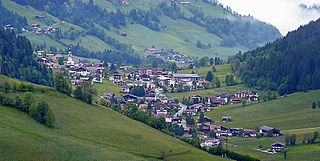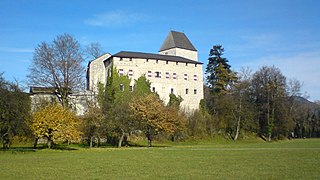
Brandenberg is a municipality in the Austrian state of Tyrol in the district Kufstein. It consists of the Brandenberg village and the Aschau locality.

Kufstein is a town in the Austrian state of Tyrol, the administrative seat of Kufstein District. With a population of about 20,000 it is the second largest Tyrolean town after the state capital Innsbruck. The greatest landmark is Kufstein Fortress, first mentioned in the 13th century. The town was the place of origin of the Austrian noble family Kuefstein.

Ellmau is a municipality in the district of Kufstein in the Austrian region of Sölllandl. It lies 12 km southeast of Kufstein and 9 km west of Sankt Johann in Tirol. It is located at an elevation of 820 m above sea level. It was mentioned for the first time in the records in 1155 and is nowadays part of the Ski Welt skiing area.

Wörgl is a city in the Austrian state of Tyrol, in the Kufstein district. It is 20 km (12 mi) from the international border with Bavaria, Germany.

Wattens is a market town of the Innsbruck-Land District in the Austrian state of Tyrol. It is chiefly known as home of the Swarovski crystal glass company.

Wildschönau is a municipality within the district of Kufstein in the state of Tyrol 6 km south of Wörgl.

Itter is a municipality in the Kitzbühel District in the Austrian state of Tyrol located 18.60 km west of Kitzbühel, 5 km southeast of Wörgl, and 2.5 km north of Hopfgarten im Brixental. The village lies on a terrace above the Brixental valley and its main source of income is tourism.

Angath is a municipality in the Kufstein district in the Austrian state of Tyrol located 2 km north of Wörgl and 13 km southwest of Kufstein on the northern shore of the Inn River. The village has 6 parts and acts as a dormitory suburb for commuters from Wörgl and Kufstein.

Angerberg is a municipality in the Kufstein district of Austria. It is located 2.7 kilometres (1.7 mi) north of Wörgl and 14 kilometres (9 mi) southwest of Kufstein. The village was mentioned for the first time in documents in 1190.

Bad Häring is a municipality in the Kufstein district in the Austrian state of Tyrol located 4.30 km northwest of Wörgl and 9 km south of Kufstein. A strong sulfur source was found in 1951 resulting in foundation of health tourism. In 1996 the location was named the "first air spa of Tyrol“.

Breitenbach am Inn is a municipality in the Kufstein district in the Austrian state of Tyrol located 5.5 km west of Wörgl and 19 km southwest of Kufstein. The village has five parts and received new parts and house numbers in 2006. It was founded in the middle of the 19th century.

Kirchbichl is a municipality in the Kufstein District in the Austrian state of Tyrol located 10 km south of Kufstein and 3 km northeast above Wörgl. It has six parts and its main source of income is cement industry.

Kramsach is a municipality in the Kufstein district in the Austrian state of Tyrol located 27 km southwest of Kufstein and 16.5 km west of Wörgl, at the northern side of the Inn River. Its main sources of income are the marble, timber and glass industries, as well as summer tourism. Kramsach is also known as the "Lake village of Tyrol" because there are six lakes nearby.

Mariastein is the smallest municipality in the Kufstein district in the Austrian state of Tyrol located 4 kilometers north of Wörgl and 11.5 kilometers southwest of Kufstein. Already a fifteenth century pilgrimage destination, it became more popular after a local statue of Mary, which had been removed to Bavaria in the late seventeenth century, was said to have returned to the church in Mariastein on its own.

Münster is a municipality in the Kufstein district in the Austrian state of Tyrol located 20 km west of Wörgl and 34 km southwest of Kufstein. It is the westernmost community of the district and lies at the northern side of the Inn River. The main sources of income are tourism, agriculture and a bottling factory for mineral water.

Radfeld is a municipality in the Kufstein district in the Austrian state of Tyrol located 1 km east of the town of Rattenberg, 13 km west of Wörgl, and 24 km southwest of Kufstein.

Reith im Alpbachtal is a municipality in the Kufstein district in the state of Tyrol located in the Alpbachtal valley, 32.9 km southwest of Kufstein, 19.6 km west of Wörgl, and 44.1 km east of Innsbruck, the main capital of Tyrol.

Söll is a municipality in the district of Kufstein in the Austrian region of Sölllandl. It is located 9 km south of Kufstein and 9 km east of Wörgl. The village consists of 25 subdivisions. The main sources of income are agriculture and tourism.

Wörgl Hauptbahnhof is the main railway station of Wörgl, a city in the Kufstein district of the Austrian federal state of Tyrol, about 20 km from the state border with Bavaria. It is a major hub for regional and international rail travel, both passenger and freight.

Kufstein railway station serves the city of Kufstein, in the Kufstein district of the Austrian federal state of Tyrol. Opened in 1876, it is an Austrian-German border station, close to the border between Tyrol and Bavaria.


























